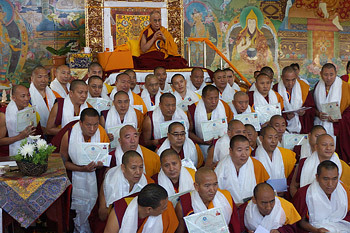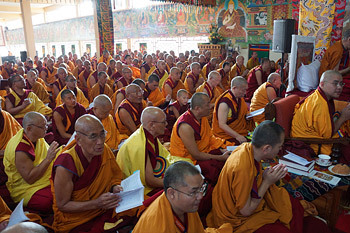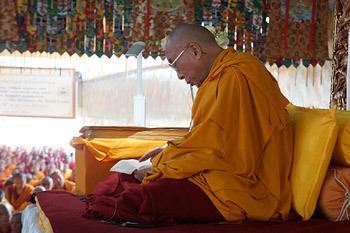Bylakuppe, Karnataka, India, 27 December 2013 - “Here we have the Ganden Tri Rinpoche, the regent of Je Tsongkhapa, and the two hierarchs, the Jangtse and Sharpa Chojeys. With them I have been asked to preside over the presenting of certificates to those who have achieved the Geshe Lharampa degree,” was how His Holiness the Dalai Lama opened the morning teaching session today. There is several years’ backlog of successful candidates, making several hundred altogether and they will be presented their certificates over the coming days.
“You’ve worked hard, memorizing root texts and commentaries, then studying them word by word. And after that you have examined and tested your understanding on the debate yard, refuting others’ views, asserting your own and rebutting criticism. You’ve studied the science of mind, employed logic and some of you have also learned Sanskrit and Tibetan grammar to refine your comprehension. This certificate you’re receiving is not intended to improve your income or your reputation, but to indicate the studies you’ve done that enable you to subdue your minds.”

|
His Holiness the Dalai Lama with some of the monks who received their Geshe Lharampa certificates at the start of his third day of teachings at Sera Jey Monastery in Bylakuppe, Karnataka, India on December 27, 2013. Photo/Jeremy Russell/OHHDL
|
His Holiness pointed out that Je Tsongkhapa has given us an example in that he studied, reflected on what he’d learned and then practised day and night. He worked for the flourishing of the Dharma and the attainment of enlightenment.
“If you have scriptural and experiential knowledge, you have something you can share with others who have an interest in the Dharma. You can help people change their outlook on life. This is crucial when there are people who need help, some of whom are so unhappy and depressed that they commit suicide.
“When I first entered the monastery there was an elderly abbot of Deyang Monastic College, who said, ‘If 100 of these monks achieve something, the number is small, but if one ends up a disgrace, that’s one too many.’ As Gelugpa Geshes you should now shine and show your worth.”
His Holiness remarked that the fact that the Buddha came into the world, taught the Dharma and the Sangha is in harmony is a source of happiness. The Nirmanakaya or Emanation Body only appears one at a time. He appeared in India about 2600 years ago, we have his teachings in the 108 volumes of the Kangyur. He showed the path to Nirvana and omniscience. As followers of the Buddha we all recite the words of refuge, yet previously in Tibet we had very little contact with other Buddhist countries. Since coming into exile we have had more connection, but after 54 years relations are still quite distant. There is good practice of the Vinaya, monastic discipline, in Burma, Thailand and Sri Lanka and His Holiness said he has encouraged improving contacts with them.
His Holiness said he has also discussed convening meetings of Vinaya masters from other Buddhist countries with the Tibetan religious office, with a view to mutual learning and enrichment. Sometimes, he said, it’s important to take the initiative. Harmony in the Sangha is a source of joy and happiness. Meanwhile, he wryly observed that the only Buddhist country he has been able to visit consistently is Japan.
Concerning the matter of the ordination of Bhikshunis, discussions and research are still going on. Whether a decision can be reached about this or not, everyone has the right to study and the nuns have been doing so. They have recently held their own Jang Göncho debate meeting and it’s been decided to grant qualified candidates a Geshema degree. Inside Tibet too nuns are showing interest in study of the classic texts. These are all signs of progress.
“I met someone from Kham recently who told me there is harmony and good relations among the different traditions there, which is helpful for everyone.”

|
Some of the many thousands of monastics attending His Holiness the Dalai Lama's third day of teachings at Sera Jey Monastery in Bylakuppe, Karnataka, India on December 27, 2013. Photo/Jeremy Russell/OHHDL
|
“Once I started studying with Khunu Lama Rinpoche I developed a wish to receive the Guhyagarbha empowerment from him. I consulted both my tutors about my wish. When I confided in Kyabje Ling Rinpoche, he suggested I could do so, but not then. At the time, I used to propitiate Dolgyal, but he did not. He told me that in the context of talk about preserving your lineage purely it might be better not to take the Guhyagarbha empowerment, so I didn’t do it.
“During the 13th Dalai Lama’s time Terton Lerab Lingpa was the holder of the Vajrakilaya practice which was introduced at Namgyal Monastery. But in order to do it you needed the empowerment. I hadn’t received it, so we requested Kalu Rinpoche to give it. We would do the practice for the benefit of the Tibetan administration and all beings. When I wanted to receive the empowerment, Ling Rinpoche was in Dharamsala and Trijang Rinpoche was in Bodhgaya. In order to reach a decision I performed a dough ball divination before the Jowo Wati Sangpo statue, the sacred image of Avalokiteshvara from Kyirong, in my residence and the response was positive. I received the Vajrakilaya empowerment for the first time from Dilgo Khyentse Rinpoche and subsequently undertook the retreat.
“This was my first Nyingma empowerment and I performed a dough ball divination to decide whether I should stop propitiating Dolgyal. The answer was ‘Yes’. I enquired whether I should stop immediately or gradually, keeping in mind that it was Losar and there was a custom of performing certain rituals on the third day. To the question about whether I should delay or stop right away the answer was ‘Right away’. So I stopped, but didn’t tell anyone about it until I received a letter from Ganden Jangtse about troubles they were facing. Trijang Rinpoche told them it had to do with a conflict with Palden Lhamo, but I’m not going to go into details about that now.
“Regarding the dough ball divination, it’s something I’ve done since I took responsibility for Tibet’s spiritual and temporal affairs. There are times when I discuss questions with others, but when no conclusion is reached, I rely on this method. When I looked into whether I should stop Dolgyal practice, it was not a whimsical enquiry.”
His Holiness explained that after receiving the Vajrakilaya empowerment from Dilgo Khyentse Rinpoche he received other transmissions from Trulshik Rinpoche. He spoke of finding the comparison between what Guhyasamaja has to say, Je Rinpoche’s explanations of emptiness and the Nyingma account to be very helpful. He said this is how he began to put the idea of non-sectarianism into practice.
He said it has not shaken his view that Je Rinpoche is an incomparable proponent of the Madhyamaka view, nor that in terms of personal practice that we should not lose our own traditions. But when a sincere Kinnauri practitioner asked him for a Nyingma practice and he was unable to help him he regretted it. He recalled that it says in the ‘Ornament of Clear Realizations’ that Bodhisattvas should know all the paths and develop them within themselves.

|
His Holiness the Dalai Lama during the third day of his teachings at Sera Jey Monastery in Bylakuppe, Karnataka, India on December 27, 2013. Photo/Jeremy Russell/OHHDL
|
“On this auspicious day, Je Tsongkhapa’s anniversary I’d like us to recite his biography of training, ‘Destiny Fulfilled’. This text relates how he studied broadly with all the traditions then extant in Tibet. In his writings you can see how he read, studied and then wrote in detail about what he had understood. We should follow in his footsteps in our own study and practice.”
His Holiness resumed his expository reading of the ‘Gomchen Lam Rim’. He stopped shortly before lunch, suggesting that it would be appropriate on this auspicious day to commemorate Je Rinpoche by reciting the first chapter of the ‘Ornament of Clear Realizations’ and the second chapter of Chandrakirti’s ‘Entering the Middle Way’.
After lunch he completed reading Ngawang Drakpa’s ‘Gomchen Lam Rim’ and began Panchen Lobsang Chogyan’s ‘Easy Path’. When he reached the section about death and impermanence, His Holiness mentioned that most of us feel 99% confident we will not die before the day is out, but none of us feel 100% sure. He recalled that when he left Tibet in 1959, there were so many things he had to leave behind, such as clothes that had belonged to the previous Dalai Lamas. He could not really think of taking anything. And when he left the Norbulingka that night he didn’t know if he would see the next day or not. When he completed reading the text before the end of the afternoon, he remarked that he used to have friends who had memorized it and could recite it by heart, something he thought completely admirable.
The day’s teaching session concluded with a fervent recitation of Khedrup –je’s praise of Je Tsongkhapa, ‘Glorious in the Three Realms’.















